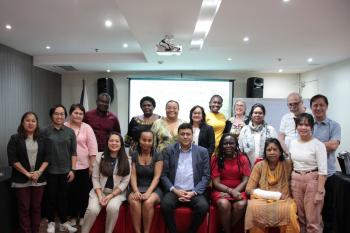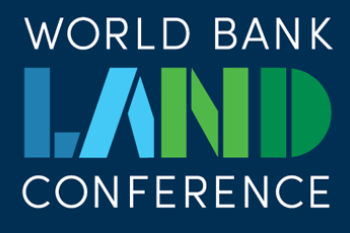Moving the Needle Forward on Land Rights in the Sustainable Development Goals
Blog by Tim Hanstad,Co-Founder & Senior Advisor at Landesa .
Originally published on the LandPortal Foundation website.
A relatively obscure and technical determination earlier this week by a relatively little-known international body could mean a sea change in economic and social empowerment prospects for hundreds of millions of women and their families. Insecure rights to land constrain opportunity for over 2 billion people living in urban and rural informality. And women fare the worst. Whether by law or customary practice, women continue to face barriers to their land and inheritance rights in more than half the world. Instead of enjoying equal and secure access to the land on which they live or from which they earn a livelihood, their only claim to land is through their relationship to a male relative – a husband, father, or brother. Consequently, their rights to land can dissolve if that relationship changes — if a husband asks for a divorce, a father dies, or a brother migrates out of the area for work. This lack of tenure security undermines their economic development and their standing in their communities. Governments and policymakers have a unique opportunity to empower women financially and socially by ensuring that their rights to land are protected. This has a profound ripple effect on household income, food security, health, and other positive outcomes for women, their families, and communities. At the macro level, securing women’s land rights could stimulate entire economies, help grow a more food secure future(link is external), and even activate new allies in our response to climate change. The foundational importance of land rights in determining social and economic outcomes for rural women, men and communities is increasingly recognized. Yet, land rights were not part of the earlier Millenium Development Goals.If governments and the broader development community were going to “move the needle forward” on land rights, the MDGs did not prioritize the effort.That changed with the follow-on to the MDGs. When the United Nations adopted the 2030 Agenda for Sustainable Development in Sept. 2015, land rights were included in the targets on goals related to poverty, hunger, and gender equality. Getting land rights targets into the 2030 Agenda was a major step forward. Those targets, however, would be of questionable value without a way to measure progress toward those targets. How could governments and the broader global development community move the needle forward on land rights without a gauge -- or without agreement on exactly what the gauge was to measure?
The land-related targets in the 2030 Agenda included three proposed indicators, but until this week, it was not clear that those three indicators would be meaningfully implemented.The international body that determined which of the 240 SDG indicators should be prioritized – the Inter-Agency and Expert Group on Sustainable Development Goal Indicators (IAEG-SDGs) – has a three-tier ranking system for determining whether a given indicator would be meaningfully implemented. At the beginning of this year, all three land indicators were stuck in Tier III, the lowest priority category, at risk of being dropped from the get-go. Indicator 5a.1, which measures the percentage of people with secure rights to agricultural land and the share of women among agricultural landholders, was elevated to Tier II status in April, but that left the important indicators 1.4.2 and 5a.2 still mired in the irrelevance of Tier III status. On Sunday, however, the IAEG-SDGs decided to reclassify the remaining two tenure security indicators — dealing with land tenure security and legal protections for women’s land rights —from Tier III to Tier II status. The promotion to Tier II signals that there is agreement at the global level on the methodology for collecting data to track progress toward both indicators. That means that governments worldwide now have a green light to implement the methodology and begin collecting the necessary data to incorporate and monitor land rights as part of their obligations to the Sustainable Development Agenda. And it gives the 2030 Agenda a robust set of land rights indicators for tracking progress on the Sustainable Development Goals. Indicator 5.a.2 is an important element of such progress tracking.
Indicator 5.a.2 measures the ‘Proportion of countries where the legal framework (including customary law) guarantees women’s equal rights to land ownership and/or control.’Establishing a legal framework – both formal and informal – is not sufficient for ensuring women’s equal land rights, but it is typically necessary. As such, monitoring progress on this legal framework will draw attention to this necessary (albeit not sufficient) element. Indicator 5.a.2 provides a framework for governments, built on recognized standards like the Voluntary Guidelines on Responsible Governance of Tenure (VGGT) and the UN Convention on the Elimination of Discrimination Against Women (CEDAW), for adopting and implementing laws and policies for strengthening women’s land and inheritance rights. This includes provisions for joint registration of land, equal inheritance rights for sons and daughters and for widows to receive an inheritance share, and for protecting women’s land rights in customary settings. Importantly, progress toward Indicator 5.a.2 will be measured not only through women’s legal (including through customary law) attainment of secure rights to land and inheritance, but through their involvement in decision-making on land transactions at the household level, access to financial support to enter land markets, and participation in land administration and management institutions. Strengthening women’s participation in decision-making bodies and their access to financial resources can help ensure policy gains at the national level reach the ground. And companion indicators 1.4.2 and 5.a.1 will further incentivize governments to implement the gender equitable policies sought by 5.a.2. The elevation of all three land tenure indicators to Tier II status is an important milestone worth celebrating. However, we still have other milestones ahead. To achieve Tier 1 classification, at least 50% of all countries in all regions must collect data and report regularly on the land tenure indicators. This will require:
- Funding: Donors, international bodies, and governments will need to step up with the needed financial resources to regularly collect and use the data.
- Capacity building: NGOs, international bodies and governments will need to build the capacity at the country level to generate data, to determine what additional data may be needed, and to identify lessons and good practices.
- Supporting the use of new data and evidence. If the collected data is to become meaningful, the global development community must invest some effort into promoting friendly and effective framing and communication of the data, into developing the capacity of decision-makers who rely on this data, and into disseminating and integrating good practices and lessons learned.


